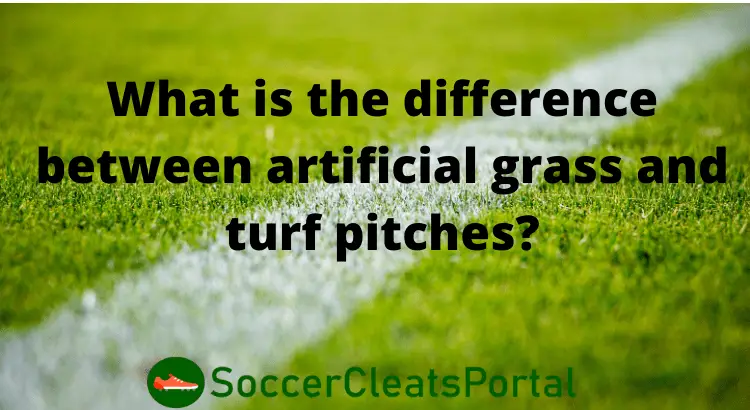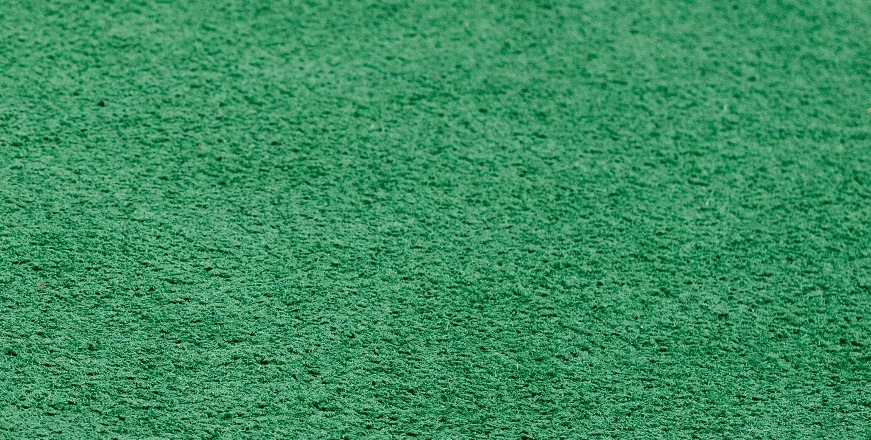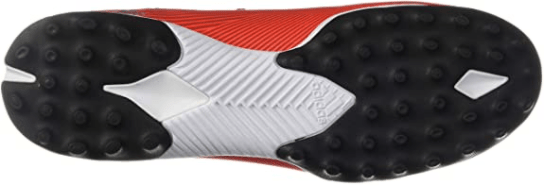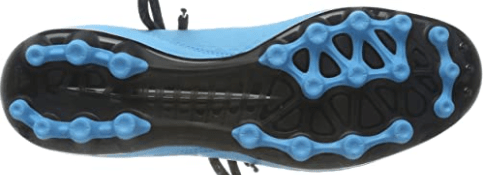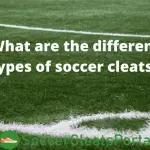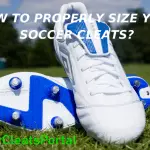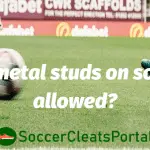When it comes to artificial soccer surfaces most people think that that artificial grass is the same as turf. The truth is that these two surfaces are a lot different so the soccer cleat brands have to manufacture separate types of soccer cleats for each surface.
But what is the main difference between artificial grass and turf? The main difference mainly comes down to the depth of the playing surface. Turf is more of like a rough carpet material that’s very shallow while artificial grass looks more like real grass with plastic blades of grass.
Turf is the first generation of artificial plain surfaces and while artificial grass surfaces are considered the evolution of the most abrasive synthetic pitches. But let’s see a little more info about the history of artificial surfaces and the effect they have on the soccer game.
Artificial surfaces in soccer
Artificial surfaces have become very popular in soccer nowadays with many teams installing them in their stadium. They first introduced to the FIFA ”Laws of the game’‘ in 2004 and from the season 2005-2006 are officially permitted in all the FIFA competitions as soon as the ground meets some standards with the 2015 FIFA Women’s World Cup to be the first major competition to be played solely on artificial grass.
The main reasons that artificial surfaces are used are the following:
1. They reduce the cost of maintenance as they do not require irrigation or trimming.
2. They can confront unfavorable weather conditions, especially in places with severe winters.
3. They are the ideal solution for indoor or partially covered soccer fields that are not exposed to enough sunlight for the grass to stay healthy.
The disadvantages of the use of synthetic surfaces in soccer are:
1. Temperatures of artificial surfaces on sunny days exceed those of natural grass thus increasing the risk of dehydration and reducing the reaction times of the players.
2. Skin abrasions and burns are a lot more likely to occur when playing on turf or artificial grass due to the increased friction of the synthetic grass textures. Also, turf can actually increase stress on the joints with joint sprains to be more likely to occur on artificial turf than on natural grass.
3. In comparison to natural grass they have a limited lifetime.
4. The black dots used in turf fields to fill the space between artificial blades of grass, also called ”crumb rubber”, are actually shredded car and truck tires. Those are made from heavy metal and with players swallowing or inhaling those materials, many health concerns have been raised about the safety of artificial grounds on the players.
5. Finally, a soccer ball will retain more of its speed when bouncing on synthetic grounds creating an overall faster game, with an adverse effect on the player’s control of the ball and the over viewer experience.
But what the difference is between the synthetic surfaces and which boots should you wear on turf and which boots should you wear on artificial grass?
Turf Surfaces and Turf Soccer Shoes (TF)
Turf is the first generation of artificial surfaces.
This a very abrasive surface if you slide on it you could easily cut some skin off. The length is very short and the whole ground looks like a carpet.
Also turf ground tends to become really hot in summer making it very painful to slide or tackle on them.
A turf surface typically is going to have a thin layer of sand underneath or just concrete. If there’s sand it’ll be a little bit softer if it’s just concrete obviously it’ll be very very hard. Also, they will have double the amount of rubber balls than artificial grasses.
With that in mind, turf shoes are made out of a durable rubber material. They utilize many small rubber spikes dispersed throughout the entire outsole which are very short in length just to dig into the very shallow turf surface.
Artificial Grass Surfaces and Artificial Grass Cleats (AG)
Artificial grass looks more like real grass as it features plastic fibers of grass that match the length of natural grass. They are also called Third Generation or 3G pitches.
Typically you’ll find either sand or more commonly small rubber pellets scattered throughout the surface.
When it comes to artificial grass there will notice a lot of variation from one field to the next. This depends on the quality of the artificial grass itself where lower quality fields are going be more shallow and higher quality fields will have longer blades of grass and typically more depth meaning that they’re going to have a softer feel as you’re running around. But, in order for a specific artificial field to be used eventually, it has to pass the strict FIFA requirements as shown in the video below.
Just like regular natural grass you want studs for optimal traction but not a firm ground stud pattern. Firm ground boots are made specifically for use on natural grass both in regards to performance as well as durability so when you use an FG boot on artificial grass and they break really quickly. More info about this subject you can find in my article for the differences between AG and FG cleats.
AG stud patterns and soleplates are becoming more common as the artificial grass pitches become more popular.
The soleplate is made from thicker plastic in order to deal better with the harsh surface that is artificial grass, especially during the summer when it can get very hot. You’ll notice that they have an extended plastic lip around the forefoot and toe box area in order to prevent sole separation. The studs are similar in length to firm ground boots but you can see that they are conical in shape and actually hollow in the middle in order not to be overly clingy on an artificial grass surface. They are also more in number and distributed through the soleplate.
Every soccer cleat brand offers a mix of FG and AG stud patterns which are designed for use on artificial grass as well. They are not as good as a true AG stud pattern but they offer safety and are as durable as the AG cleats.
What about the other type of cleats on synthetic surfaces?
When it comes to wearing just FG boots on artificial grass I would strongly recommend against that. You are putting yourself at a higher risk of injury and of course, the durability of the boots long-term will definitely take a hit. For more information about AG and FG boots, you can visit my article about the differences between AG and FG cleats.
FG boots on turf surfaces should be avoided mainly for safety reasons.
SG cleats should be definitely avoided on synthetic surfaces. SG cleats feature metal studs so they are completely inappropriate for the hard artificial grounds. You can put yourself in danger while it is very possible to ruin the playing surface. You can read more about SG cleats in my article about the eligibility of metal studs in soccer.
When it comes to indoor soccer shoes you can play on both surfaces but it is not that recommended. Artificial surfaces can be very slippery for the flat soles of indoor shoes.
But, what about the types of soccer shoes that are specifically designed for synthetic grass pitches?
Can I Wear Artificial Grass Cleats on Turf or Turf Soccer Shoes on Artificial Grass?
Both artificial grass and turf are synthetic grasses that simulate natural grass. However, these surfaces aren’t built in the same way. Artificial grass is the best synthetic grass on the market. If professional players play on an artificial surface it’ll always be on artificial grass. It seems very similar to natural grass but it’s more abrasive, which means that it’ll hurt more when you fall or slide on this terrain.
On the other hand, turf is an artificial playing surface that is slowly becoming obsolete. Turf quality is much lower than artificial grass. It’s shallow like a carpet and provides very little cushioning. It would hurt a lot to fall on this terrain.
If you play on artificial grass it’s best to use AG soccer cleats. AG stands for Artificial Grass. They have specialized soleplates with rounded rubber studs. Studs’ length is designed specifically for these types of surfaces. They won’t penetrate the ground as your usual soccer cleat would. This will prevent injuries that happen when studs get stuck in synthetic grass. The AG soccer cleats are also more durable on abrasive grounds.
You should be able to play on turf in AG soccer cleats without any problems, as they don’t penetrate the surface. Their studs are round and rubbery so they won’t get stuck in the turf. You may experience some problems with stud pressure on your feet from the hardness of the terrain, but nothing too serious.
As for the turf soccer cleats, they are manufactured with a unique soleplate that’s meant to be used on turf. It’s made of rubber and it’ll provide you with lots of cushioning on this hard surface. Turf cleats are also made to be very durable as they’re used on an especially abrasive terrain. The studs are short and distributed equally on the sole of the shoe. This is great for a shallow surface like turf and the studs will also help with equal distribution of your weight.
Also, turf shoes can easily be used on artificial grass terrains. You won’t have as much traction as with AG cleats but you’ll have enough to play without any major issues.
